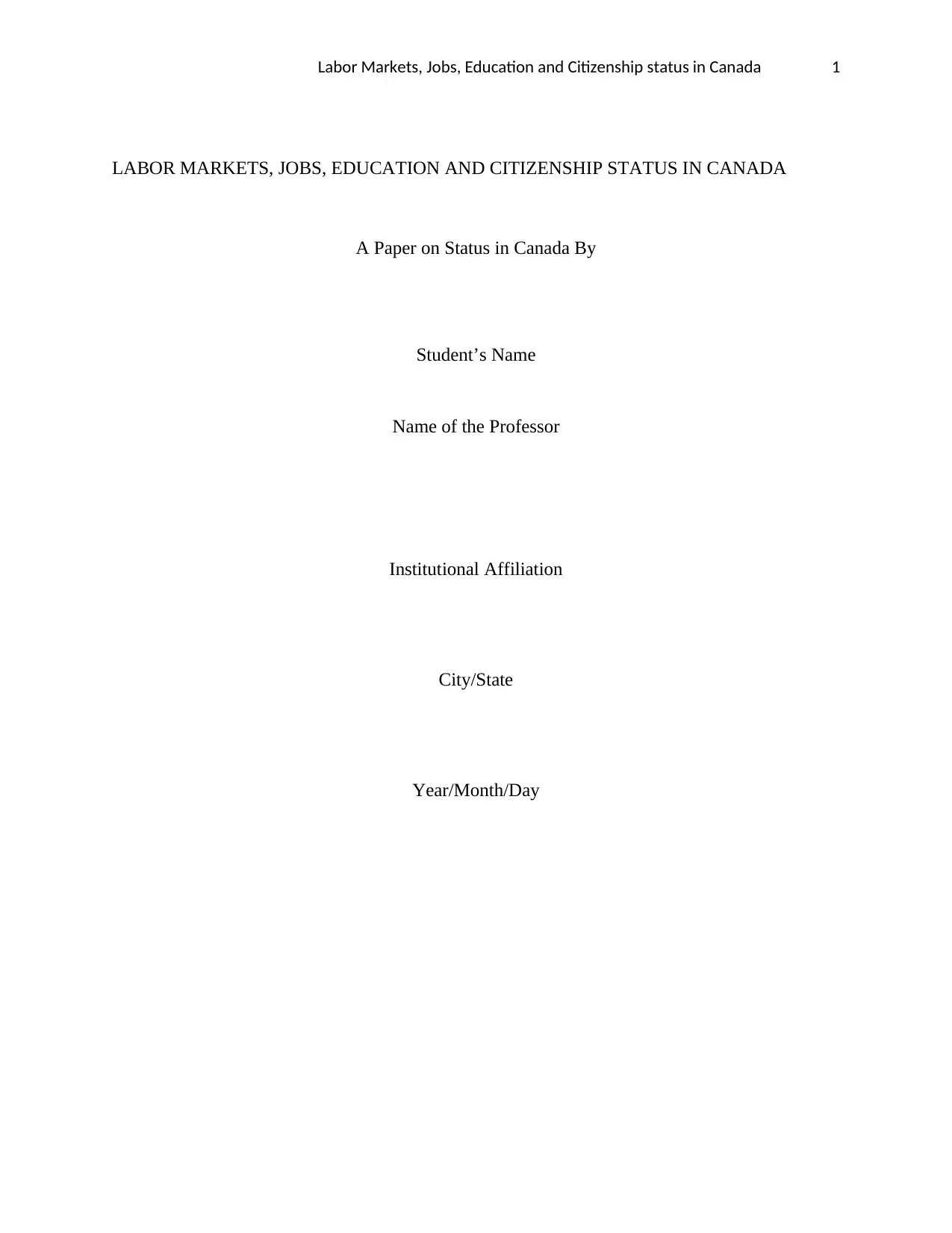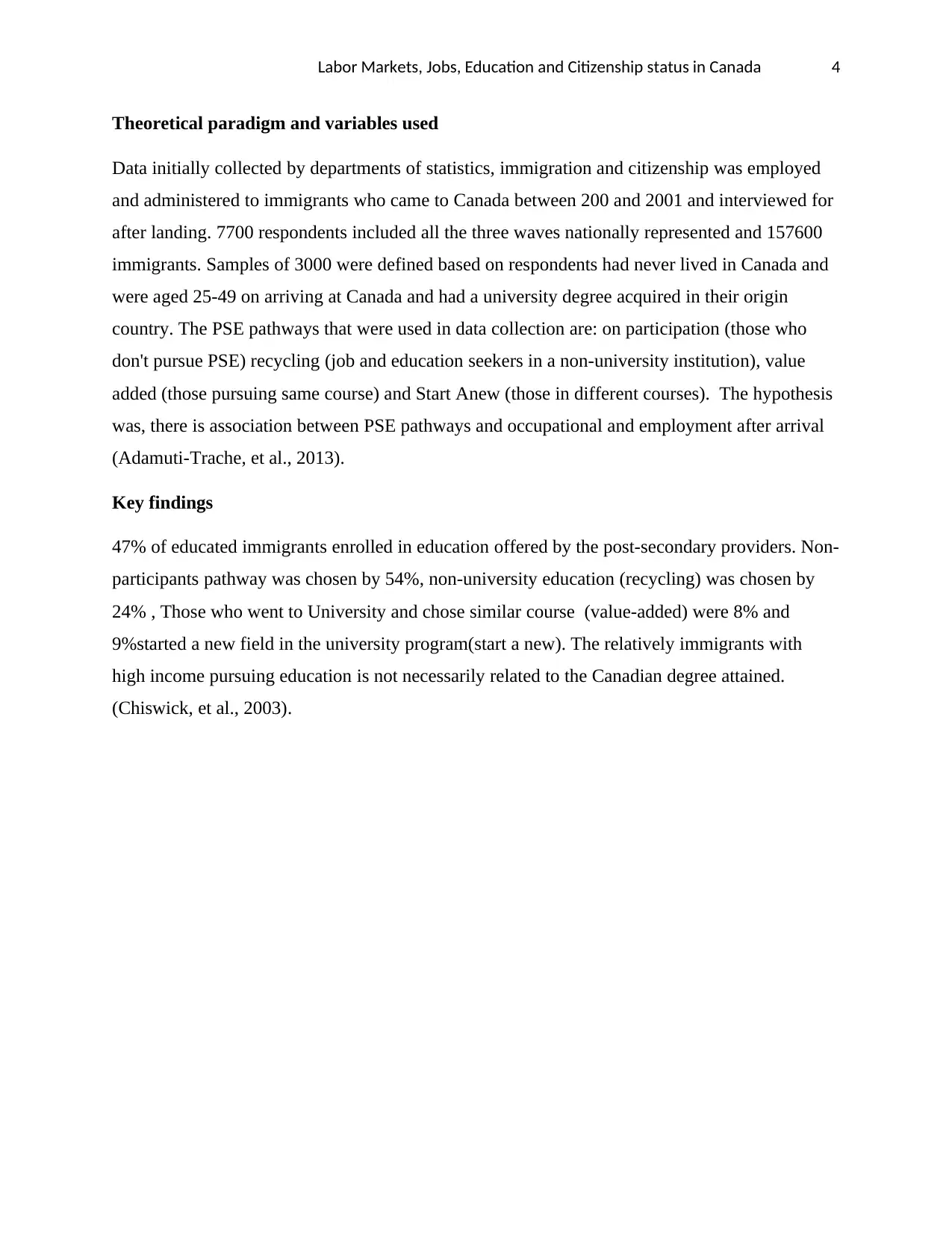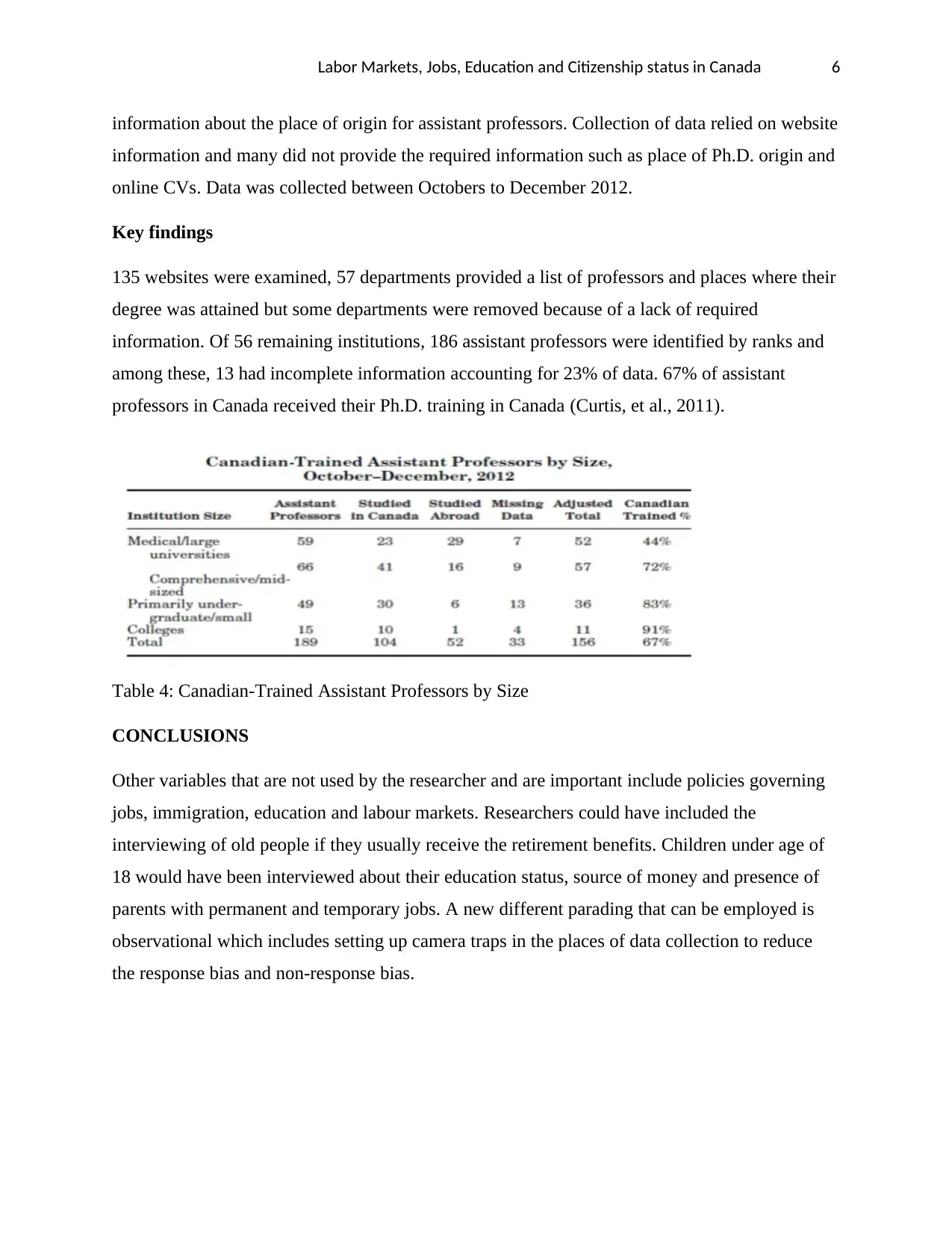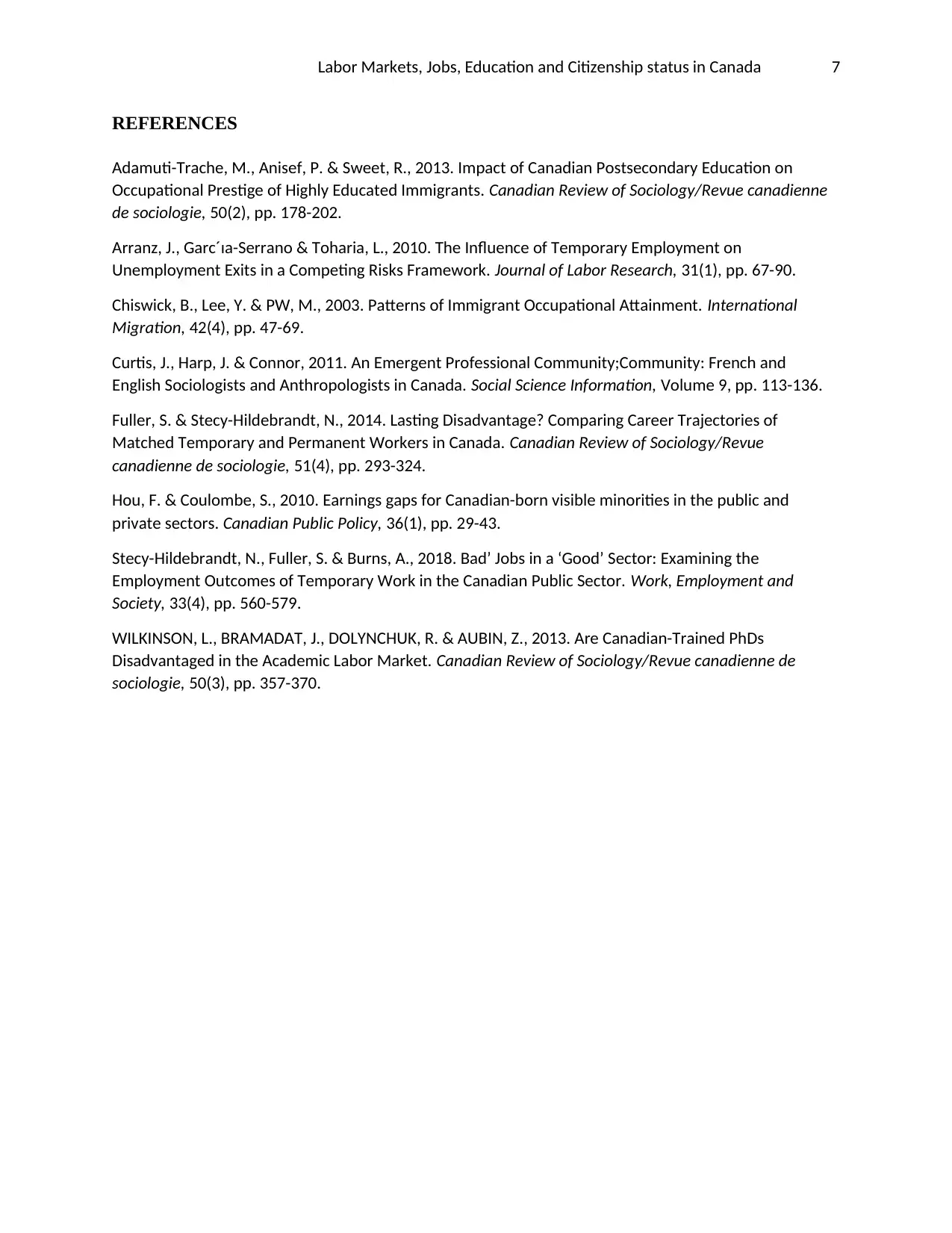Labor Markets, Jobs, Education, and Citizenship in Canada Report
VerifiedAdded on 2022/08/23
|8
|1546
|15
Report
AI Summary
This report synthesizes information from several articles to provide an overview of labor markets, jobs, education, and citizenship status in Canada. It examines the public sector's role in providing employment, the impact of education and citizenship on job outcomes, and the challenges faced by immigrants in the labor market. The report also explores the academic labor market, focusing on the hiring practices of Canadian universities. Key findings include the importance of unionization and employment benefits in the public sector, the influence of post-secondary education on immigrant occupational prestige, and the preference of Canadian universities for Canadian-trained PhDs. The report uses sociological imaginations and critical thinking to analyze the variables, relationships, and theoretical paradigms presented in the articles, offering insights into the complexities of the Canadian labor landscape. The report also considers additional variables and alternative research approaches to provide a more comprehensive understanding of the topics discussed.

Labor Markets, Jobs, Education and Citizenship status in Canada 1
LABOR MARKETS, JOBS, EDUCATION AND CITIZENSHIP STATUS IN CANADA
A Paper on Status in Canada By
Student’s Name
Name of the Professor
Institutional Affiliation
City/State
Year/Month/Day
LABOR MARKETS, JOBS, EDUCATION AND CITIZENSHIP STATUS IN CANADA
A Paper on Status in Canada By
Student’s Name
Name of the Professor
Institutional Affiliation
City/State
Year/Month/Day
Paraphrase This Document
Need a fresh take? Get an instant paraphrase of this document with our AI Paraphraser

Labor Markets, Jobs, Education and Citizenship status in Canada 2
INTRODUCTION
This paper synthesizes the article information about labor markets, jobs, education and
citizenship status, and income and uses sociological imaginations and critical thinking as the
issues in the articles are discussed. It has covered the variable used, the relationship between
them, the key findings and theoretical paradigm used by the researchers.
Jobs
The public sector has provided equitable and favorable employment. Formal practices of human
resources, equal policies, levels of high unionization and greater accountability of the public
have attributed to stable and profitable employment. The favorable employment condition of the
sector may extend to temporary employees who benefit from unionization and equity.
Variables used
Job and demographic properties applied as variables were: age, education, years of experience,
major income earner in the family, marital status, residence, job tenure, occupation and status of
the job. Variables used were months of employment, months out of labor force payments receipts
(Stecy-Hildebrandt, et al., 2018)
The theoretical paradigm used by the researcher
Three aspects of job quality were considered to examine the favorable sector for temporary
workers: Access earnings when on leaves, benefits, and security of employment. This involves
comparing collective agreement for workers with permanent and temporary status in public
sectors. Six codes were compared across CA: workforce adjustment and pay measured
employment security, parental, maternity, vacation and sick leave and ability to benefit from
leaves. The provision was coded inferior and unspecified according to provision of CA. Five
years earning trajectories for both workers aged 18-60 were compared from 1999 to 2010
(Arranz, et al., 2010).
INTRODUCTION
This paper synthesizes the article information about labor markets, jobs, education and
citizenship status, and income and uses sociological imaginations and critical thinking as the
issues in the articles are discussed. It has covered the variable used, the relationship between
them, the key findings and theoretical paradigm used by the researchers.
Jobs
The public sector has provided equitable and favorable employment. Formal practices of human
resources, equal policies, levels of high unionization and greater accountability of the public
have attributed to stable and profitable employment. The favorable employment condition of the
sector may extend to temporary employees who benefit from unionization and equity.
Variables used
Job and demographic properties applied as variables were: age, education, years of experience,
major income earner in the family, marital status, residence, job tenure, occupation and status of
the job. Variables used were months of employment, months out of labor force payments receipts
(Stecy-Hildebrandt, et al., 2018)
The theoretical paradigm used by the researcher
Three aspects of job quality were considered to examine the favorable sector for temporary
workers: Access earnings when on leaves, benefits, and security of employment. This involves
comparing collective agreement for workers with permanent and temporary status in public
sectors. Six codes were compared across CA: workforce adjustment and pay measured
employment security, parental, maternity, vacation and sick leave and ability to benefit from
leaves. The provision was coded inferior and unspecified according to provision of CA. Five
years earning trajectories for both workers aged 18-60 were compared from 1999 to 2010
(Arranz, et al., 2010).

Labor Markets, Jobs, Education and Citizenship status in Canada 3
Key findings
Public sectors are known as good employment because of high unionization and employment
benefits and security.
Table 1: 1. Employment status for both Workers in CA
22 out of 27 CA openly laid regulations for adjustment of workforce. For all 27CA compensation
provisions were inferior because of their predictions on status of employment. All CA needed
titled employees to continuously work for six months to be paid when on maternity leaves. In 27
CA, workers needs working a minimum numbers 75hrs per month, some 80 hrs. Per 20 weeks
and some 10 days per month to be paid when on vacation and sick leaves (Hou & Coulombe,
2010).
Education and citizenship
Many people believe that education abroad is cheaper in Canada by maintaining a barrier to
recognize the credentials that are foreign and ignoring the value of education’s outcome. Despite
the requirement for workers with good skills in occupants that need high education levels.
Important human capital specific to the country that is essential to labor is formal education.
Immigrants pursuing education after arrival get social and cultural capital that is advantageous
economically. Education from destination country make the immigrants to build ties outer their
ethnic network and become familiar with labor markets to enhance their assurance to better jobs
with good pay and prestige (Fuller & Stecy-Hildebrandt, 2014)
Key findings
Public sectors are known as good employment because of high unionization and employment
benefits and security.
Table 1: 1. Employment status for both Workers in CA
22 out of 27 CA openly laid regulations for adjustment of workforce. For all 27CA compensation
provisions were inferior because of their predictions on status of employment. All CA needed
titled employees to continuously work for six months to be paid when on maternity leaves. In 27
CA, workers needs working a minimum numbers 75hrs per month, some 80 hrs. Per 20 weeks
and some 10 days per month to be paid when on vacation and sick leaves (Hou & Coulombe,
2010).
Education and citizenship
Many people believe that education abroad is cheaper in Canada by maintaining a barrier to
recognize the credentials that are foreign and ignoring the value of education’s outcome. Despite
the requirement for workers with good skills in occupants that need high education levels.
Important human capital specific to the country that is essential to labor is formal education.
Immigrants pursuing education after arrival get social and cultural capital that is advantageous
economically. Education from destination country make the immigrants to build ties outer their
ethnic network and become familiar with labor markets to enhance their assurance to better jobs
with good pay and prestige (Fuller & Stecy-Hildebrandt, 2014)
⊘ This is a preview!⊘
Do you want full access?
Subscribe today to unlock all pages.

Trusted by 1+ million students worldwide

Labor Markets, Jobs, Education and Citizenship status in Canada 4
Theoretical paradigm and variables used
Data initially collected by departments of statistics, immigration and citizenship was employed
and administered to immigrants who came to Canada between 200 and 2001 and interviewed for
after landing. 7700 respondents included all the three waves nationally represented and 157600
immigrants. Samples of 3000 were defined based on respondents had never lived in Canada and
were aged 25-49 on arriving at Canada and had a university degree acquired in their origin
country. The PSE pathways that were used in data collection are: on participation (those who
don't pursue PSE) recycling (job and education seekers in a non-university institution), value
added (those pursuing same course) and Start Anew (those in different courses). The hypothesis
was, there is association between PSE pathways and occupational and employment after arrival
(Adamuti-Trache, et al., 2013).
Key findings
47% of educated immigrants enrolled in education offered by the post-secondary providers. Non-
participants pathway was chosen by 54%, non-university education (recycling) was chosen by
24% , Those who went to University and chose similar course (value-added) were 8% and
9%started a new field in the university program(start a new). The relatively immigrants with
high income pursuing education is not necessarily related to the Canadian degree attained.
(Chiswick, et al., 2003).
Theoretical paradigm and variables used
Data initially collected by departments of statistics, immigration and citizenship was employed
and administered to immigrants who came to Canada between 200 and 2001 and interviewed for
after landing. 7700 respondents included all the three waves nationally represented and 157600
immigrants. Samples of 3000 were defined based on respondents had never lived in Canada and
were aged 25-49 on arriving at Canada and had a university degree acquired in their origin
country. The PSE pathways that were used in data collection are: on participation (those who
don't pursue PSE) recycling (job and education seekers in a non-university institution), value
added (those pursuing same course) and Start Anew (those in different courses). The hypothesis
was, there is association between PSE pathways and occupational and employment after arrival
(Adamuti-Trache, et al., 2013).
Key findings
47% of educated immigrants enrolled in education offered by the post-secondary providers. Non-
participants pathway was chosen by 54%, non-university education (recycling) was chosen by
24% , Those who went to University and chose similar course (value-added) were 8% and
9%started a new field in the university program(start a new). The relatively immigrants with
high income pursuing education is not necessarily related to the Canadian degree attained.
(Chiswick, et al., 2003).
Paraphrase This Document
Need a fresh take? Get an instant paraphrase of this document with our AI Paraphraser

Labor Markets, Jobs, Education and Citizenship status in Canada 5
Table 2: Outcomes of employment by groups of PSE Pathway
Table 3: Occupational Prestige of Main Job
LABOUR MARKETS
There are many attempts to record histories and sociology in Canada which is believed to be
irreversible in decline since the 1970s. It is believed that more academically important
department of sociology evade rule of hiring Canadians first making the job description specific.
Few Canadians can apply to make prestigious institutions to hire foreign-trained in a Canadian
university (WILKINSON, et al., 2013).
Theoretical paradigm and variables used
More departments were examined and classified professors by ranks and where they got their
doctoral degrees. There was a control for date of hire and this limited the analysis to those hired
as assistant professors. The investigation was preliminary analysis and it was not easy to get
Table 2: Outcomes of employment by groups of PSE Pathway
Table 3: Occupational Prestige of Main Job
LABOUR MARKETS
There are many attempts to record histories and sociology in Canada which is believed to be
irreversible in decline since the 1970s. It is believed that more academically important
department of sociology evade rule of hiring Canadians first making the job description specific.
Few Canadians can apply to make prestigious institutions to hire foreign-trained in a Canadian
university (WILKINSON, et al., 2013).
Theoretical paradigm and variables used
More departments were examined and classified professors by ranks and where they got their
doctoral degrees. There was a control for date of hire and this limited the analysis to those hired
as assistant professors. The investigation was preliminary analysis and it was not easy to get

Labor Markets, Jobs, Education and Citizenship status in Canada 6
information about the place of origin for assistant professors. Collection of data relied on website
information and many did not provide the required information such as place of Ph.D. origin and
online CVs. Data was collected between Octobers to December 2012.
Key findings
135 websites were examined, 57 departments provided a list of professors and places where their
degree was attained but some departments were removed because of a lack of required
information. Of 56 remaining institutions, 186 assistant professors were identified by ranks and
among these, 13 had incomplete information accounting for 23% of data. 67% of assistant
professors in Canada received their Ph.D. training in Canada (Curtis, et al., 2011).
Table 4: Canadian-Trained Assistant Professors by Size
CONCLUSIONS
Other variables that are not used by the researcher and are important include policies governing
jobs, immigration, education and labour markets. Researchers could have included the
interviewing of old people if they usually receive the retirement benefits. Children under age of
18 would have been interviewed about their education status, source of money and presence of
parents with permanent and temporary jobs. A new different parading that can be employed is
observational which includes setting up camera traps in the places of data collection to reduce
the response bias and non-response bias.
information about the place of origin for assistant professors. Collection of data relied on website
information and many did not provide the required information such as place of Ph.D. origin and
online CVs. Data was collected between Octobers to December 2012.
Key findings
135 websites were examined, 57 departments provided a list of professors and places where their
degree was attained but some departments were removed because of a lack of required
information. Of 56 remaining institutions, 186 assistant professors were identified by ranks and
among these, 13 had incomplete information accounting for 23% of data. 67% of assistant
professors in Canada received their Ph.D. training in Canada (Curtis, et al., 2011).
Table 4: Canadian-Trained Assistant Professors by Size
CONCLUSIONS
Other variables that are not used by the researcher and are important include policies governing
jobs, immigration, education and labour markets. Researchers could have included the
interviewing of old people if they usually receive the retirement benefits. Children under age of
18 would have been interviewed about their education status, source of money and presence of
parents with permanent and temporary jobs. A new different parading that can be employed is
observational which includes setting up camera traps in the places of data collection to reduce
the response bias and non-response bias.
⊘ This is a preview!⊘
Do you want full access?
Subscribe today to unlock all pages.

Trusted by 1+ million students worldwide

Labor Markets, Jobs, Education and Citizenship status in Canada 7
REFERENCES
Adamuti-Trache, M., Anisef, P. & Sweet, R., 2013. Impact of Canadian Postsecondary Education on
Occupational Prestige of Highly Educated Immigrants. Canadian Review of Sociology/Revue canadienne
de sociologie, 50(2), pp. 178-202.
Arranz, J., Garc´ıa-Serrano & Toharia, L., 2010. The Influence of Temporary Employment on
Unemployment Exits in a Competing Risks Framework. Journal of Labor Research, 31(1), pp. 67-90.
Chiswick, B., Lee, Y. & PW, M., 2003. Patterns of Immigrant Occupational Attainment. International
Migration, 42(4), pp. 47-69.
Curtis, J., Harp, J. & Connor, 2011. An Emergent Professional Community;Community: French and
English Sociologists and Anthropologists in Canada. Social Science Information, Volume 9, pp. 113-136.
Fuller, S. & Stecy-Hildebrandt, N., 2014. Lasting Disadvantage? Comparing Career Trajectories of
Matched Temporary and Permanent Workers in Canada. Canadian Review of Sociology/Revue
canadienne de sociologie, 51(4), pp. 293-324.
Hou, F. & Coulombe, S., 2010. Earnings gaps for Canadian-born visible minorities in the public and
private sectors. Canadian Public Policy, 36(1), pp. 29-43.
Stecy-Hildebrandt, N., Fuller, S. & Burns, A., 2018. Bad’ Jobs in a ‘Good’ Sector: Examining the
Employment Outcomes of Temporary Work in the Canadian Public Sector. Work, Employment and
Society, 33(4), pp. 560-579.
WILKINSON, L., BRAMADAT, J., DOLYNCHUK, R. & AUBIN, Z., 2013. Are Canadian-Trained PhDs
Disadvantaged in the Academic Labor Market. Canadian Review of Sociology/Revue canadienne de
sociologie, 50(3), pp. 357-370.
REFERENCES
Adamuti-Trache, M., Anisef, P. & Sweet, R., 2013. Impact of Canadian Postsecondary Education on
Occupational Prestige of Highly Educated Immigrants. Canadian Review of Sociology/Revue canadienne
de sociologie, 50(2), pp. 178-202.
Arranz, J., Garc´ıa-Serrano & Toharia, L., 2010. The Influence of Temporary Employment on
Unemployment Exits in a Competing Risks Framework. Journal of Labor Research, 31(1), pp. 67-90.
Chiswick, B., Lee, Y. & PW, M., 2003. Patterns of Immigrant Occupational Attainment. International
Migration, 42(4), pp. 47-69.
Curtis, J., Harp, J. & Connor, 2011. An Emergent Professional Community;Community: French and
English Sociologists and Anthropologists in Canada. Social Science Information, Volume 9, pp. 113-136.
Fuller, S. & Stecy-Hildebrandt, N., 2014. Lasting Disadvantage? Comparing Career Trajectories of
Matched Temporary and Permanent Workers in Canada. Canadian Review of Sociology/Revue
canadienne de sociologie, 51(4), pp. 293-324.
Hou, F. & Coulombe, S., 2010. Earnings gaps for Canadian-born visible minorities in the public and
private sectors. Canadian Public Policy, 36(1), pp. 29-43.
Stecy-Hildebrandt, N., Fuller, S. & Burns, A., 2018. Bad’ Jobs in a ‘Good’ Sector: Examining the
Employment Outcomes of Temporary Work in the Canadian Public Sector. Work, Employment and
Society, 33(4), pp. 560-579.
WILKINSON, L., BRAMADAT, J., DOLYNCHUK, R. & AUBIN, Z., 2013. Are Canadian-Trained PhDs
Disadvantaged in the Academic Labor Market. Canadian Review of Sociology/Revue canadienne de
sociologie, 50(3), pp. 357-370.
Paraphrase This Document
Need a fresh take? Get an instant paraphrase of this document with our AI Paraphraser

Labor Markets, Jobs, Education and Citizenship status in Canada 8
1 out of 8
Your All-in-One AI-Powered Toolkit for Academic Success.
+13062052269
info@desklib.com
Available 24*7 on WhatsApp / Email
![[object Object]](/_next/static/media/star-bottom.7253800d.svg)
Unlock your academic potential
Copyright © 2020–2025 A2Z Services. All Rights Reserved. Developed and managed by ZUCOL.